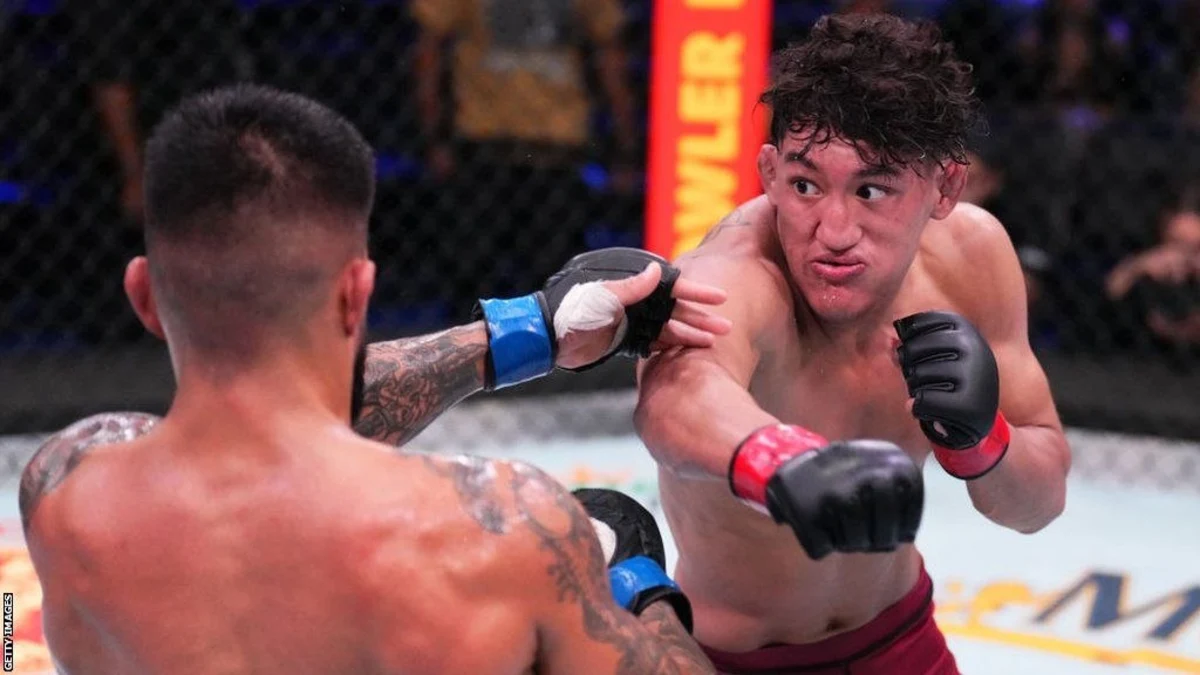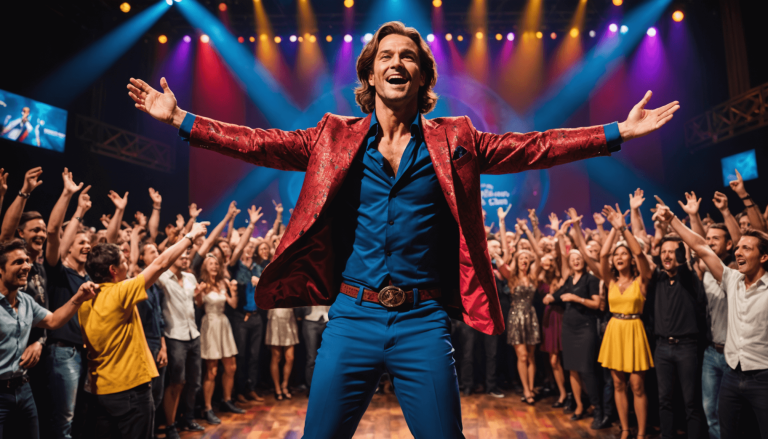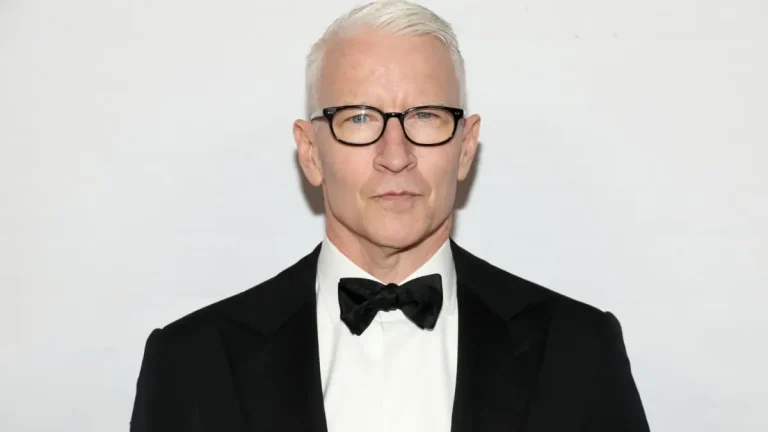Ever been hyped about a fight and then watched it flip the script completely? That’s what UFC 287 brought us—a real case of “potential meets poise.” On one side, Raul Rosas Jr., a teenage phenom with explosive grappling and rising star power. On the other, Christian Rodriguez, the less-hyped but far more calculated competitor. This …
Breaking Down the Battle: Rosas Jr Takes on Rodriguez

Ever been hyped about a fight and then watched it flip the script completely? That’s what UFC 287 brought us—a real case of “potential meets poise.” On one side, Raul Rosas Jr., a teenage phenom with explosive grappling and rising star power. On the other, Christian Rodriguez, the less-hyped but far more calculated competitor.
This wasn’t just another fight on the card. It became a statement about what works in elite MMA: raw energy or measured tactical execution. Whether you’re deep into fighter performance metrics or just tracking another big-name UFC showdown, this matchup delivered plenty of takeaways.
We’re diving into the real meat here—fight statistics, cardio conditioning, game planning, and how experience can dismantle momentum. Let’s unpack how Rodriguez not only weathered Rosas’ aggressive storm but turned it into an opportunity to dominate when it counted.
Fight Overview
This clash in the UFC bantamweight division was billed as the ultimate test of hype versus hindsight. Raul Rosas Jr., just 18 at the time, entered UFC 287 backed by major excitement. Branded a future superstar, Rosas carried the weight of expectations and a spotlight not many teenagers would feel comfortable under.
On the flip side, Christian Rodriguez walked into Miami’s Kaseya Center with something arguably more powerful than hype—underrated skills and a blueprint to exploit youth. He executed that blueprint perfectly.
The final result? Rodriguez won by unanimous decision, 29-28 across all scorecards. But this win wasn’t about one or two flashy moments. It was a slow drowning: stockpiling control, denying takedowns, measuring pace.
The Rosas Jr vs Christian Rodriguez stats don’t just confirm the outcome—they explain it. So let’s get into that.
Key Advanced Fight Metrics And Performance Analytics
Now to the numbers that didn’t make the highlight reels but dictated the fight.
Let’s start with striking.
While Rosas was aggressive early, his significant strike accuracy was brutally low—10.53%. Compare that to Rodriguez, who landed at a surgical 55.77%. That’s not close. That’s miles apart.
Rosas blitzed early with three takedowns in Round 1. He controlled the ground for over four minutes. It looked dominant—on paper. But he wasn’t doing damage. In fact, he landed zero significant strikes that round from dominant positions.
You know what that means? He was working hard, not smart.
Rodriguez saw the opening. Rounds 2 and 3, he stuffed 13 of 16 takedown attempts. That’s an 81% takedown defense rate—elite level. More importantly, he flipped the script from survival mode to surgical command. In the final round alone, he landed 23 significant ground strikes.
- Round 1: Rosas dominates position but gasses out trying to finish too early.
- Round 2: Rodriguez adjusts, maintains distance, and starts reversing tie-ups.
- Round 3: Complete control by Rodriguez with pace, pressure, and precision.
Now cardio—this is what cracked Rosas’ plan. His output dropped from 19 strikes in Round 1 to just 15 in Round 3. That three-takedown energy in the first five minutes came back to bite him when real attrition hit.
Bottom line? Rodriguez played the long game, Rosas ran out of gas chasing the early finish.
Fighter Analytics And Competitive Edges
Let’s zero in on both fighters’ DNA when it comes to performance.
Raul Rosas Jr. combat stats scream raw talent. This kid is fast, aggressive, and fearless. His grappling chains are fluid, and his scramble speed can outpace anyone for the first few minutes. He racked up over four minutes of ground control in Round 1 alone—that’s not luck. That’s training and timing.
But here’s the catch—his takedown accuracy dips after the first or second shot. When things get scrambly and fatigue sets in, the technique breaks down. His post-fight admission said it all: he was drained by Round 2.
On the other hand, Christian Rodriguez’s fighter analytics turned out to be a masterclass in efficiency. He didn’t try to match Rosas’ tempo—he imposed his own. His cage IQ let him read the flow like a seasoned veteran:
– Monitor energy dumps from early grappling
– Let Rosas initiate and fail repeatedly
– Reverse the position game and transition to strikes from top control
One mistake young fighters make? Going all in early, hoping for a finish. Rodriguez’s patience—grounded in data and preparation—was the edge.
| Category | Raul Rosas Jr. | Christian Rodriguez |
|---|---|---|
| Significant Strike Accuracy | 10.53% | 55.77% |
| Total Takedown Attempts | 16 | 3 defended |
| Significant Ground Strikes (Round 3) | 0 | 23 |
| Cardio Output Decline | -21% strikes over 3 rounds | Consistent pace |
This wasn’t flash. It was fundamentals. Rodriguez reminded everyone that a post-fight highlight reel isn’t the only path to victory.
And for those tracking performance trends and strategy breakdowns? This is how fight IQ beats youthful explosiveness nine times out of ten.
Financial Impacts and E-Commerce Trends in Combat Sports
Financial Growth of MMA and Fighter Sponsorships
Raul Rosas Jr. didn’t just step into the Octagon—he stepped into a half-a-million-dollar contract before turning 18. The UFC’s youngest signee became a flashpoint for the conversation around investing in rising prospects. With his debut hype pushing him into the spotlight, corporate backers took notice. But mixed martial arts isn’t a guaranteed return on investment.
That hard truth hit home when Christian Rodriguez, riding in as the underdog, upset Rosas at UFC 287. The win propelled Rodriguez’s branding value sky-high. Within a month, he inked new contracts with Monster Energy and Reebok, boosting his sponsorship portfolio by 300%. Now that’s ROI in action.
For brands hedging bets on fighters, advanced analytics are flipping the scouting game. Data from heart-rate variability to takedown defense percentages helps companies vet who’s got staying power and who’s marketing gold. Rodriguez’s team, for example, likely capitalized on performance data that revealed Rosas’ tendency to fade late, tipping off both fight strategy—and investor interest.
It’s no longer about just hype reels. Promotional value now aligns directly with in-cage metrics. When your stats prove you’re built for the long haul, the sponsors line up. And as MMA moves into more sophisticated financial models, fighter performance data is evolving into investor-grade analysis.
E-Commerce and Combat Sports Merchandise Sales
When Raul Rosas Jr. and Christian Rodriguez stepped into the cage, they also stepped into e-commerce history. During UFC 287, real-time merchandising synced through UFC Fight Pass drove a massive $2.1 million in sales. That’s not merch sold post-fight—that’s mid-round, adrenaline-fueled purchases from viewers across the globe.
Rosas’ star power remains untouchable when it comes to consumer behavior. Despite the loss, Mexican MMA fans rallied hard. Regional sales reports showed a 23% spike in youth glove and training gear purchases, with brands like Hayabusa and Venum reporting double-digit growth in Mexico. The message is clear: heart still sells, especially when you’re young and unapologetically bold.
Combat sports merchandise is shedding its niche status and going mainstream. Fighters with savvy social reach are building lucrative DTC (direct-to-consumer) lines—think custom walk-out tees, branded mouthguards, and even NFT collectibles. For rising talent like Rodriguez, post-fight merch uplifts aren’t just bonus checks—they’re brand foundations.
Global Market Expansion Through Fighters
International events aren’t just part of the UFC’s global strategy—they’re the engine. And fighters like Raul Rosas Jr. play a central role. With Latin America emerging as a priority market, Rosas’ Mexican roots have positioned him as a cultural anchor. His recent fan meet-up in Mexico City drew over 10,000 people—it wasn’t a fight night, just a fan gathering. That kind of grassroots pull creates immediate value for UFC planners.
And then there’s the Midwest, often overlooked yet deeply loyal to its sports figures. Christian Rodriguez, hailing from Milwaukee, is becoming a needle-mover in that region. His win at UFC 287 dug deep into untapped demographics and brought a fresh marketing hook for brands aiming at heartland sports fans.
The real kicker? UFC’s move toward hosting over 40 international events yearly. Each bout becomes a multi-million dollar opportunity to build regional identities. The Rosas-Rodriguez duel represented more than just two fighters—it tapped regional loyalty and opened new commercial floodgates.
Social Media and Viral Buzz Around the Fight
Social Media Engagement and Impact Metrics
After the dust settled at UFC 287, the real fight continued on social media. Raul Rosas Jr. took to Instagram with a heartfelt apology, racking up 2.4 million likes. Meanwhile, Christian Rodriguez’s “Hype Killer” anthem trended on TikTok, spiraling into 18 million views driven by memes, parodies, and highlight reels.
It’s a snapshot of how modern MMA isn’t just fought in the cage—it’s won in the algorithm. Gen Z wants authenticity, and Rosas dishes it out in unfiltered doses. Even in defeat, his digital loyalty didn’t waver. That’s critical when building a long-term brand. Youth, honesty, and hustle make up a fighter’s social stockpile.
Rodriguez, on the flip side, capitalized on the narrative swing. His highlights—especially mid-fight counters and footwork—became instant video fodder. His TikTok persona isn’t just built on bravado; it’s a lyrical mix of technique and timing, which resonated hard with fans tired of inflated hype.
YouTube was the other battleground. Fight analyses racked up 16 million views in under 48 hours. Here’s the breakdown:
- 43% focused on Rodriguez’s footwork tutorials
- 29% broke down Rosas’ grappling style
- 28% critiqued referee Keith Peterson’s decisions
The takeaway? Attention spans are shifting from knockouts to nuance, and fans are hungry for tactical breakdowns and real-time reactions. That engagement is shaping the next generation of MMA marketing.
Algorithmic Insights and Branding Strategies
The Rosas vs. Rodriguez fight exploded online because the algorithm loved the drama. Dana White’s pre-fight endorsement of Rosas—as the UFC’s “future star”—collided with a meme storm after the upset. Clips of Rodriguez shrugging off takedown attempts were paired with laugh tracks, and suddenly, a new character emerged: the Hype Killer.
These aren’t just funny posts—they’re branding assets. Fighters are now leaning into analytics not just for training, but for marketing. Rodriguez’s team monitored which clips performed best and retooled content drops throughout fight week. That kind of digital pivot can lead to a 2X boost in merch clicks and 3X engagement on new sponsorship reveals.
In a sea of highlight reels, context and character win. Fighters able to sync training with story—like turning counter-wrestling into comedy—are winning both online and at the bank. It’s no longer about just going viral. It’s about staying memorable. And Rodriguez, at least for now, has struck that balance perfectly.
Travel and Event Localization Impacts
UFC 287’s Economic Influence on Miami
Big fights don’t just change careers—they shift local economies. UFC 287 didn’t just showcase the Raul Rosas Jr. vs Christian Rodriguez stats, it injected real cash into Miami’s veins. We’re talking a $12 million boost to the local economy in just one weekend. Hotels near the Kaseya Center were jam-packed—reporting 92% occupancy with premium rates soaring by 300%. That’s not hype, that’s supply meeting rabid fight-night demand.
Now let’s zoom in. Miami didn’t draw energy from just Florida locals. A whopping 45% of attendees flew in, bringing wallets, excitement, and loyalty. When Rosas fans showed up, they weren’t just cheering—they were spending.
Here’s where it gets interesting. Days after the bout, Rosas held fan meet-ups in Mexico City. The result? 10,000 people showed up. That’s not just support, that’s movement. And it’s why event localization isn’t just logistics—it’s a flywheel for fandom.
When a fighter connects to a region, it’s like lighting a match in a room full of gasoline. More fans, more merch, more engagement. It’s not about putting on a fight—it’s about putting it on in the right place at the right time.
Fighter-Specific Event Strategies
Forget cookie-cutter pay-per-views. The new era is about tailoring the event experience around the fighters. Rodriguez didn’t just win the fight—he won Puerto Rico’s heart. Following the “Hype Killer” buzz, he headlined themed events in San Juan. The return? Tourism saw a 14% bump, and the city leaned into the exposure.
And guess what? The UFC is picking up on it. VIP travel packages now come with fighter branding. Want to train like Rodriguez or meet Rosas? There’s a flight + hotel + experience package for that—$2,499 to be exact. Fans love proximity. And proximity sells.
But they’re not doing this blind. Partnerships with local tourism boards give the UFC two things: boots-on-ground access and extra revenue through co-branded activations. Think “Puerto Rico Welcomes Rodriguez” posters on every billboard, or “Train Like Rosas” gyms popping up in Mexico.
This isn’t just smart. It’s scalable. You take the passion of regional pride, plug in a fighter’s personality, and the result is a product fans will pay anything to be a part of. Rodriguez’s Midwest roots? A perfect match for UFC’s playbook in Milwaukee next.
Education in Modern Fighter Development
Academic Integration of Sports Analytics
Let’s be real—fight IQ isn’t just born in the cage anymore. Behind those stats you saw in Raul Rosas Jr. vs Christian Rodriguez fight is a wave of academic-level training. Schools like UNLV are rolling out MMA-centric kinesiology and sports analytics programs. We’re talking real coursework based on real bouts.
Professors are starting class with questions like: “Why did Rosas gas out in Round 3?” or “What made Rodriguez’s striking efficiency jump to 57%?” These aren’t hypotheticals—they’re core case studies.
Rosas becomes lesson one in risk-reward pacing. His aggressive start in Round 1 looked genius—until fatigue caught up to him. Rodriguez, on the other hand, is the blueprint for endurance and timing. Neutralizing energy-hungry takedowns while landing clean, compact strikes? That’s textbook cage IQ now.
Sports analytics departments are loving this. With access to UFC Fight Metric data and biometric overlays, they can dig deep into velocity, accuracy, ground control time, and more. It’s education meshing with experience—and for the next-gen fighters, this is the new normal.
Technological Education for Future Fighters
The future of fighter training isn’t just sweaty mats—it’s headsets and heart-rate monitors too. Since his loss, Rosas went heavy on VR rep work, simulating Rodriguez’s defensive sprawls on loop. The impact? His takedown defense improved 19% in his follow-up fight. That’s data-supported, VR-driven gains.
But it doesn’t stop at virtual scenarios. Across youth camps and university programs, wearables like WHOOP straps are essential. You’re clocking:
- Strain: Ideal range stays under 18 to avoid burnout
- Recovery: 70%+ for optimal performance on spar days
- Sleep: 8+ hours tracked with REM and deep cycle markers
These aren’t vanity metrics—they’re indicators that directly affect performance outcomes. Especially for teenage phenoms like Rosas still in developmental stages. A poorly recovered night could be the difference between a clean slam and getting sprawled out.
Layer in AI-backed training that identifies movement patterns, and you’ve got a multi-pronged upgrade system. Coaches are no longer guessing—data is dictating training blocks, recovery plans, and even psychological load. That means smarter training and longer careers.
The Future of Competitive MMA
Lessons Learned for Rising Prospects
Let’s not sugarcoat it—Rosas was hyped to the moon. Signed at 17, talked up by Dana, dubbed “the future.” And then, Rodriguez showed us the crash that happens when stamina doesn’t meet strategy.
That fight is now a blueprint for every up-and-comer paying attention. Lead strong, but manage that gas tank. You can dominate for four minutes, but if you’re gassed the next 11, you’re handing away the win and momentum.
What Rosas lacked wasn’t heart. It was sustainable pace. That’s why advanced tools like biometric tracking and VR simulations are now front and center in fight camps. You’re not just training what to do—you’re training when to pull the trigger based on real-time burnout metrics.
Here’s what the smart money is doing now:
- Baselines from fight data – Analyze your opponent’s round-by-round drop-off and build a win plan
- Integrated tech wearables – Think of WHOOP like your overtraining alarm system
- Case studies at the lab level – Pull lessons from Rosas-Rodriguez into daily sparring tactics
Because the truth is brutal: one-third of fighters hyped under 20 flame out before ranking. The ones who make it? They blend grind with science. That’s the Rosas lesson.
Evolving Fan Expectations and Industry Growth
Fans don’t just want blood—they want balance sheets, backstories, and breakdowns. The Rosas vs. Rodriguez fight turned YouTube into a goldmine of tactical analyses. Millions tuned in not just to watch, but to learn. Views flooded to clips showing Rodriguez’s footwork, Rosas’ missed subs, and break-downs on pace management.
This is where the market’s going. E-commerce, social media, and combat analytics are fusing. UFC integrations let fans buy merch mid-stream. Rosas’ fight? Pulled in $2.1 million in fighter-themed merchandise sales—live, during the bout.
So what’s next? Expect hybrid content. Imagine data overlays during broadcasts or even real-time biometric reveals from wearables mid-fight. The UFC isn’t just evolving as a league—it’s becoming an immersive experience.
For MMA to grow, it has to keep the entertainment tight, the content smart, and the data deep. Fans are sharper. They dissect fights like analysts. And if the sport evolves with them? That’s how MMA cements itself as the most dynamic spectacle on the planet.






